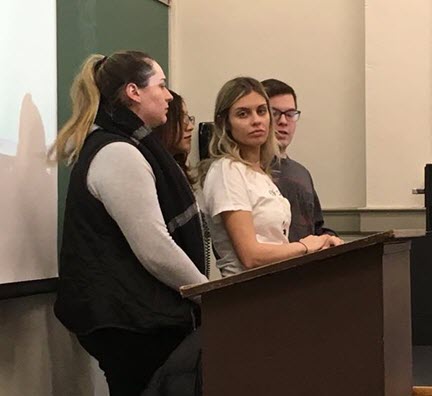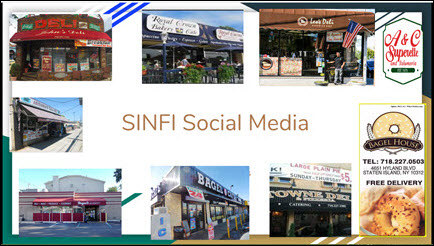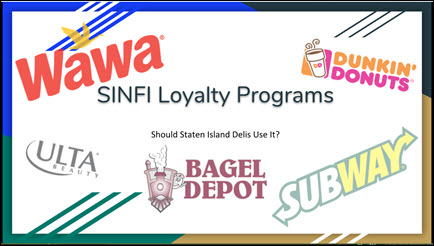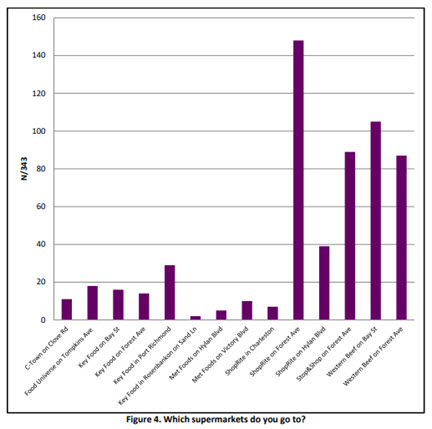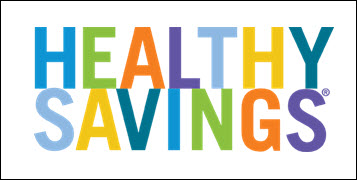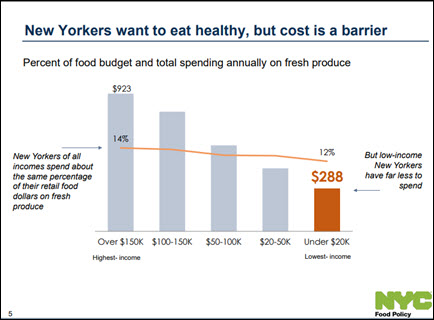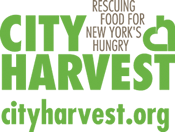Contents
- Effects of SINFI and Healthy Retail on SI Stores
- Social Media and Loyalty Cards at Delis and Cornerstores
- Favorite Supermarkets on SI
- Healthy Savings Cards
- NYC Research on Food Access
- St. John's University Study on the Effects of the My Plate Program
- Food Business Landscape on Staten Island
- Workers' Co-ops: An Alternative Way of Running a Business
Effects of SINFI and Healthy Retail on SI Stores
In addition to publicizing ethnic and friendly corner stores, SINFI has sometimes acted as a “feeder” organization for City Harvest’s Healthy Retail program. In 2018, SINFI identified a cohort of small food businesses and supermarkets from which City Harvest could collect data and with which they could experiment. However, neither SINFI nor City Harvest knew what effect the programs were having on sales or marketing, if any.
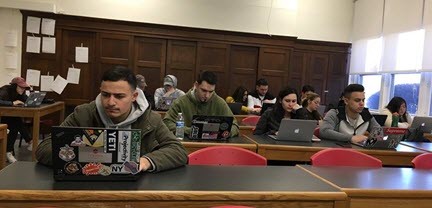
Students working on the SINFI project.
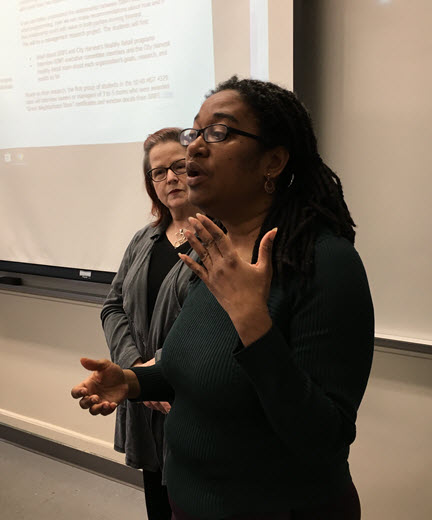
SINFI members Catherine Barnett and Diane Painter Velletri explaining the project.
In 2019, Dr. William Reisel, St. John’s University management professor, offered to survey SINFI and Healthy Retail stores for his Spring semester management classes. His seniors interviewed store owners about the effects, if any, that the SINFI and Healthy Retail projects have had on their businesses.
The students asked whether:
- The promotions sponsored by SINFI or Healthy Retail have had any effect on sales
- There have been any other measurable effects (qualitative or quantitative) on their businesses
Results
Here is the presentation on the SINFI project.
In general, most of the stores did not post their "Great Neighborhood Store" decals nor did they remember receiving them, although they agreed that it was an honor to be recognized and that they wanted to sell healthy items. They said they would appreciate help from SINFI on social media and with marketing in general.
Student reporting on the SINFI results.
Here is the presentation on the Healthy Retail project.
In general, the storeowners said that having the City Harvest Healthy Retail program helped them to differentiate their stores from other stores nearby and attract more people. Some indicated that produce sales went up because of the program.
Students reporting on the Healthy Retail results.
Social Media and Loyalty Cards at Delis and Cornerstores
Promoting a store on social media has measurable results, but deli owners often resist adding social media to their marketing mix. City Harvest and SINFI wanted to find out what makes some storeowners effective social media marketers and how their experiences could be used to help others start their own programs.
Loyalty programs are a proven method for engaging customers and encouraging them to return to the store. City Harvest and SINFI wanted to find out what makes some storeowners adopt loyalty programs and how their experiences could be used to help others start their own programs.
St. John's University students in two of Dr. William Reisel's 2018 Managerial Strategy and Policy classes looked at various stores on Staten Island to answer those questions.
Summary of Research Results, Social Media Campaigns
Goals
Using both research and interviews with deli owners who have successfully incorporated social media into their marketing campaigns, discover strategies for helping more store owners use the Internet effectively.
Rationale
Promoting a store on social media has measurable results, but deli owners often resist adding social media to their marketing mix. City Harvest and SINFI would like to discern what makes some store owners effective social media marketers and how their experiences could be used to help others start their own programs.
Questions Asked
- Do you use Facebook, Instagram, Twitter, or LinkedIn?
- If yes, what is your goal of doing so?
- If no, why not?
- What is your procedure for handling negative reviews online?
- How often do you post on social media?
- Do you run ad campaigns? If so, whom are they marketed towards? Do you see them contributing to the amount of sales generated?
- Has the use of social media increased your customer base?
Interviewees
Ariemma’s Italian Deli, Bagel Cafe, Leo’s Deli, and Towne Deli.
Results
The students found that most of the delis had Facebook and Instagram pages. “Facebook helps them to convey informational updates [marketing] to people who have their locations listed as “Staten Island, NY.” while Instagram is more for the promotion of the visuals of food products and flash specials themselves.” They also found most of the delis have simple websites that showcase their menu.
The delis rarely used Yelp “because most people place their reviews on Facebook since they already have established accounts on there and people on yelp tend to post anonymously, causing the viewer of the reviews to [mistrust them].”
Delis Reviewed |
Royal Crown Bakery |
Bagel House |
Ariemma’s Italian Deli |
A&C Superette and Salumeria |
Leo’s Deli |
John’s Deli |
Bagel Cafe |
Towne Deli and Pizzeria |
Beyar’s Market |
* |
* |
* |
* |
* |
* |
* |
* |
||
* |
* |
* |
* |
* |
* |
* |
|||
* |
* |
||||||||
Yelp |
* |
* |
* |
Recommendations
The students’ official recommendations were:
- Investigate how often your competitors are posting and conduct industry research to see the ideal amount of content to publish per day on each channel. You want to be active, but not overly active.
- Visual content gets users to click.
- Your best promotional tool is the people who like your deli. Instead of focusing all your efforts on finding new customers, why not leverage your current ones? In addition to your current customers, you can use your own employees.
- Do not ignore any comment posted to your account on social, whether stellar or critical.
Some of their observations were:
Time required: At Ariemma’s, the manager’s dad, who was retired, runs all the social media since he has the time. Leo of Leo’s Deli used to do all the Instagram photos himself, but he now encourages customers to take the pictures and post them, offloading the job onto his customers.
Generating new business: Leo told the students that customers from other boroughs who’ve seen his Instagram posts have come to try his food.
Bagel Café uses social media to build their catering business—they make friends with their customers who come in for coffee and bagels, then use SEO to promote their catering services.
A&C Superette promotes special menus on social media for the holidays and special occasions, and for catering orders. They told the students that “social media has increased their customer base. The diverse pictures they post of their food selection has gotten the attention of local customers, current and new, and has noticeably increased the crowd that comes to the deli section in particular.”
Summary of Research Results, Loyalty Program
Goals
Using both research and interviews with deli owners who have successfully developed loyalty programs, discover strategies for convincing more store owners to add this tool to their marketing toolkits.
Rationale
Loyalty programs are a proven method for engaging customers and encouraging them to return to the store. City Harvest and SINFI would like to find out what makes some store owners adopt loyalty programs and how their experiences could be used to help others start their own programs.
Questions Asked
- What do you think of the value of a loyalty program for your customers?
- Why do you use a loyalty program or why don’t you use it?
- How often do customers use the loyalty program?
- How do customers join the program?
- What would you do to improve the loyalty program?
Interviewees
Wawa’s, Petracco & Sons Deli, Ulta Beauty, Bagel Depot, A&C Superette, Dunkin Donuts, and Subway.Results
- In New York, it’s a competitive edge for delis and bodegas to attract customers and keep them coming back.
- To engage with customers, owners often like using these types of loyalty programs:
- Points system
- Rewards per dollar spent
- Special offers
- It’s easy to create for businesses of all sizes.
- Stores can use a phone app, give customers a special smart card, or use a check-off business card.
- It helps companies to keep track of how often customers come in and is another way to see how well the business is doing.
- If the loyalty program is tied to the POS database, it helps owners figure out what’s popular and should be restocked more often (Bagel Depot).
Recommendations
The students said that the owners all recommended that other business owners do the same. They all agreed that these programs take some planning, but they are worth starting. They allow them to engage with customers and it keeps these customers coming in for more rewards.
- Customers will lose interest if it is too complex. Simple goals keep attention.
- Let customers know about the program and update them with details. If people don’t know about it, they won’t participate.
- The staff needs to be trained to offer the program and to ask for the card each time the customer pays for an item. Give incentives to the staff members as well.
- Rewards must be attainable. Approaching and eventually reaching the goal is why they do it.
- All rewards should be decided with the customers in mind. The rewards should be something they value and something they are willing to pursue.
Favorite Supermarkets on SI
In late 2017, City Harvest's Healthy Retail program ran a survey at the two Staten Island Mobile Markets (Stapleton and Mariners Harbor), the Trinity Lutheran, Project Hospitality, and Community Health Action pantries, and Beacon Christian Community Health Center and Community Health Center of Richmond on Canal St. to find out where people shopped:
- Did they stay in their neighborhoods or did they travel? (Answer: Most traveled, sometimes for long distances.)
- Did they buy fresh produce in the bodegas and delis near their homes or did they buy it in supermarkets? (Answer: They bought it in supermarkets.)
- Which supermarkets did they favor? (Answer: ShopRite on Richmond Ave. was the most popular store.)
The survey was given in English, Spanish, Russian, and Chinese. The results are in and there are a few surprises: Click here for a PDF version of the report.
Healthy Savings Cards
The Mayor's Office of Food Policy followed up with a pilot on Staten Island, Brooklyn, and the Bronx that offers prepaid "Healthy Savings" cards to registered pantry members and health care providers (Community Health Action of Staten Island has been registering clients on Staten Island).
Participants with a Healthy Savings card can save 50 percent off the price of fresh produce and an average of 25-30 percent off additional healthy food items such as lean meats, milk, bread, yogurt, beans, and cereal from 200 participating food companies.
Stop & Shop® and Western Beef® are the first retailers to offer the program on Staten Island. A scan of the card or app at checkout instantly discounts the foods, giving savings of up to $10 a week ($520 a year) on fresh fruits and vegetables to the shopper.
NYC Research on Food Access
At the Healthy Food Retail Action Network’s quarterly meeting on June 22, 2018, Barbara Turk, director of the Mayor’s Office of Food Policy, talked about the City’s research on food access and affordability. The slides from her talk are available here.
What about a Food Hub on Staten Island?
Susan and members of City Harvest’s Healthy Retail team attended, and at Director Turk’s invitation, Susan described the “food access hub” idea that SINFI has been exploring:
- An anchor supermarket (see slides 7-10 for the City’s ideas on siting affordable supermarkets). Director Turk said that the NYC Economic Development Corporation could help with finding a suitable location on the North Shore.
- Smaller food stores, especially ethnic or immigrant-owned, surrounding the anchor store. NYCHA Food Business Pathways graduates might own some of these stores. See https://www.nycedc.com/program/nycha-food-business-pathways for more information about the pathway program.
- Greenmarket (possibly as part of an open-air market with a variety of goods) associated with a local urban farm.
- Commercial/community kitchen for food entrepreneurs and caterers. See Staten Island Food Factory for a possible model (there is no commercial kitchen on Staten Island yet, but a small team of government, non-profit, and community members is working on it).
- Warehouse for storing fresh produce for both retailers and emergency food providers. Note that the community kitchen and warehouse can be designed as emergency resources in cases of natural or other disasters.
St. John's Study: Effects of the My Plate Program on Local Businesses
Six marketing department seniors from St. John's University, Staten Island campus, interviewed seven business owners about their experiences with SINFI's My Plate Challenge (Mexican, Peruvian, and West African events) and Showcase (Sri Lankan stores). The students, Bailey Cammarano, BriAnna Esposito, Briana Marino, Alyssa Merolo, Emante Washington-Mobley, and Caitlin Panarella, ran the study from January 20, 2017 to April 20, 2017.
Here is a summary of their recommendations:
Our suggestion for City Harvest’s MyPlate Program is two fold:
- Cross promote business owner participation through various mean of distribution (i.e. paid social media plan, press outlets native to Staten Islanders, and partnering with other local businesses)
- Utilize our marketing research to first learn consumers’ knowledge of the MyPlate Program and how to increase knowledge and awareness for our two target audiences
Click here for the complete report.
Survey Information
The students also surveyed two local populations, participants in the Trinity Lutheran soup kitchen and St. John's students, about their knowledge of and interest in the My Plate ideas. There are some interesting similarities and differences:
- Quality is important to both groups.
- Cost was more important to the soup kitchen participants.
- The soup kitchen participants were more interested in shopping tips and demos than the students.
- Neither group was familar with the My Plate guidelines.
- Healthy options were more important to the soup kitchen participants than to the students.
For all the data and the survey questions, click here.
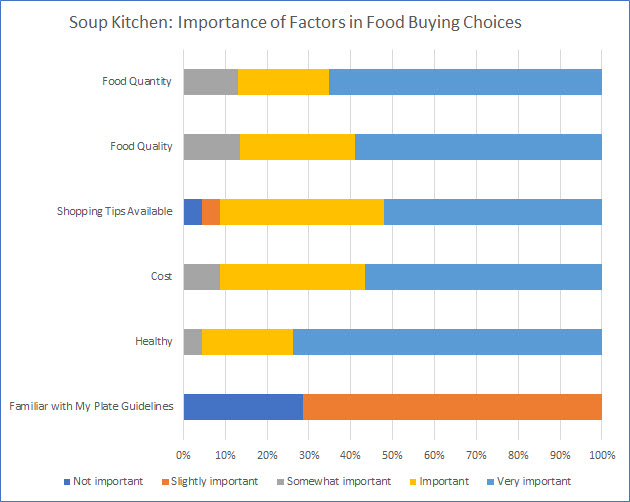
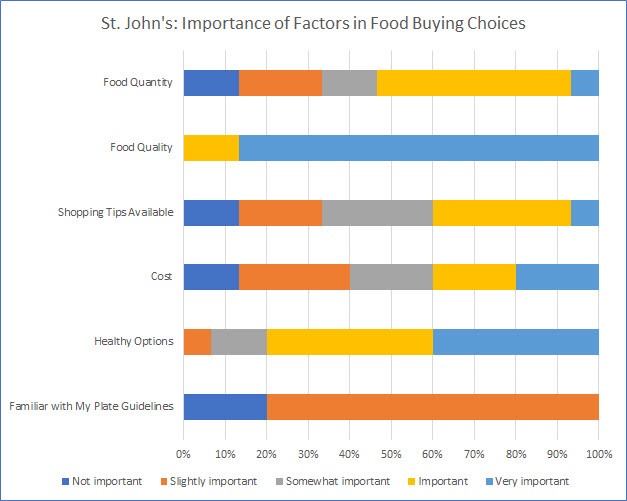
The Food Business Landscape on Staten Island
Business Think Tank Meeting, St. John’s University, Staten Island, Jan. 11, 2017
Introduction Highlights
- John Amodio: Long-time SCORE volunteer advisor on Staten Island.
- Raul Barrios: Manager, Food Retail, for City Harvest (CH), concentrating on cornerstore and bodega produce makeovers.
- Robert Fanuzzi: Promoter of service learning at St. John’s University, Staten Island. See http://www.stjohns.edu/academics/bio/robert-fanuzzi. He has involved students with the SINFI and City Harvest (CH) projects for six years.
- Susan Fowler: Manager, Community Engagement, Staten Island, for CH and director of SINFI.
- Dean Kropp: Chef, baker, organizer of the U.S. team for the Culinary Olympics 2016, and long-time CH and SINFI volunteer.
- Bianca Palumbo: Nutrition Educator for CH, SI Performing Provider System (an Affordable Care Act group; see http://statenislandpps.org/), and the Department of Health and Mental Hygiene.
- Christa Perfit: Manager, Retail Partnerships, for CH and a member of the NY Healthy Food Retail Action Network. Works with cornerstores on WIC, SNAP eligibilities, stoop permits, etc.
- William Reisel: Professor of Management at the St. John’s Peter J. Tobin College of Business. See http://www.stjohns.edu/academics/bio/william-d-reisel-phd. He has college and high school students who might be able to survey businesses identified by SINFI for levels of fresh produce and for general business acumen.
- Ben Santlofer: NYC Business Solutions senior account manager at the Staten Island center. Much of his work involves getting small business owners away from predatory “pay day” lenders. He also walks business owners through loan, MWBE, and other applications, and arranges for pre-inspections from other city agencies to help businesses get up and running faster and avoid fines. The center now has 10 to 12 people walking in every day. His office also canvasses businesses by walking through neighborhoods.
- Robert Stein: Business expert for SINFI who has met with nearly all the business owners involved with the My Plate Challenges. He wants to make sure that Staten Island gets all available city funding.
History of Healthy Retail and SINFI on Staten Island
City Harvest’s Healthy Retail program on Staten Island includes six cornerstores, a superette, and two Met Foods supermarkets. Mexico Azteca and Broad Street Supermarket on Broad St., Lanka Grocery on Victory Blvd., and Plaza San Jeronimo on Port Richmond Ave., are star stores—they’ve received free equipment and cash grants from CH and have shown significant increases in produce sales.
SINFI was started three years ago when CH staff and volunteers noticed that neighborhoods that, at first glance, looked like food deserts (or food swamps, filled with fast food) sometimes had delis or bodegas with very good fresh produce. However, since the language in the windows was Spanish, Arabic, Sinhalese, or another foreign language, the English speakers in the neighborhood would not visit the stores. SINFI decided to try to introduce the neighbors to the stores and vice versa.
To that end, SINFI has run two My Plate competitions in the Mexican/Peruvian community of Port Richmond and the West African community around Park Hill. Cornerstores, restaurants, and caterers have been involved in the competitions. SINFI also videotaped two Sri Lankan business, the San Rasa Restaurant and Lanka Grocery in Tompkinsville.
Suggestions from the Jan. 11 Meeting
Bob Fanuzzi:
Wrap the program around neighborhoods; make sure that we talk about food as a catalyst, as placemaking. We need a food hub (an “anchor tenant” like a supermarket) surrounded by a spine of businesses. There are lots of design opportunities if we work at the neighborhood level.
For a successful SINFI neighborhood, we need:
- Successful placemaking—investment, press, a demo project, etc.
- Common space for entrepreneurial trade, like a communal/commercial kitchen
- Merchant organizing—food builds a community
Bob identified three actions for SINFI to take:
- Expand outreach with CH
- See if St. John’s accounting professors and students can work with the businesses we identify
- Create public programs—warm-weather events around food.
Bob Stein and John Amodio:
Be careful to pick businesses that are really interested and capable. “They have to be able to meet you at least 10 percent of the way,” Bobby said. John has criteria he used to pick the clients he’s willing to work with, too.
Bob asked Ben and John if minorities ever get funding from traditional lenders. Ben was noncommittal but John said no, because they often can’t show that they’re making money. In a mostly cash business, you don’t make bank deposits.
John Amodio:
He said he was impressed by the CH program and didn’t know it existed. However, he said, if you get more businesses interested in the program, you might fail because CH doesn’t have enough resources—CH has only one Raul. “Let’s try to find 200 businesses but get other people to help”—for example, college and high-school students with an interest in business.
Bill Reisel:
Why not have Raul do a series of short, on-site, YouTube videos about how to manage a produce section? This might be an easier sell than asking bodega owners to come to a class, and it’s a way of cloning Raul.
Action Items
Christa: Take the YouTube idea to the consultant creating the bodega training classes. Send everyone the CH resource guide for bodegas (done).
Bill Reisel and Bob Fanuzzi: Set up a meeting of all business professors who might want a part of this project with the SINFI experts.
Susan: Invite everyone to the phone meeting with The Working World and NEBHDCo on Friday (done).
Workers' Co-ops: An Alternative Way of Running a Business
NEBHDCo and The Working World, phone meeting, Jan. 13, 2017
Smiley Rojas-Nunez opened by describing The Working World. The Working World is a non-profit that offers funding and technical assistance to workers’ cooperatives. Their goal is to build local co-op businesses.
Karen Haskins added that the organization started in Argentina and now has projects throughout Nicaragua and the U.S. as well. The organization looks for partners in the places where they hope to set up community-based programs.
Christa Perfit described City Harvest’s Healthy Retail program as an initiative to increase the produce capacity of local stores and business hygiene in general.
Ashleigh Eubanks described the Brooklyn project on which TWW and NEBHDCo partnered: In 2015, a 10-week academy, held every Monday night in Bed-Stuy, on small business planning with a focus on workers’ cooperative businesses. Of the 35 participants, three businesses wanted to do more and are continuing to work with TWW and NEBHDCo on their businesses. They have loans with two of the three businesses (Bed-Stuy Fresh and Local, Brooklyn Packers, and Skedaddle Pest Control). For more about the businesses, see http://fieldguide.capitalinstitute.org/bed-stuy-fresh-local.html and http://www.theworkingworld.org/us/loans/loans/1270.
TWW meets with the stores once a week or once every two weeks. TWW and NEBHDCo also created the Bed-Stuy Cooperative Business Project, which is currently brainstorming ways to connect with local businesses. The steering committee has a media group, a “pipeline building” group that focuses on ideas for connecting with local businesses, and a “co-op promotion” group that works with the worker-owner members of the steering committee on how to promote their cooperatives.
The steering committee is composed of people who went through the academy, the businesses they’re still working with, and local community-based organizations such as NEBHDCo, Restoration, and the Bed-Stuy BID. The committee has 10 members.
Q&A
Q: When do you run the Academy?
A: The last training with NEBHDCo was two years ago. There is no regular programming, but rather a shift to working individually with the co-ops themselves.
Q: How did you get people to come to the Academy? Business owners are notorious for not leaving their stores.
A: The sessions were 6:30-8:30 p.m. on Mondays. People who had small businesses or wanted to start businesses came. The Bed-Stuy classes were Business 101, not so much about co-ops, but the attendees were curious about the legal aspects of switching from a traditional business to a co-op business.
TWW is now working with a school, and there they go to the school itself and train them during their lunch hours, before school starts in the morning, etc. Ashleigh said that NEBHDCo has held two meetings with their community board, which should be a key partner in finding interested businesses. They’ve had one meeting with small business owners at the Pfizer Building as well. (See Food Start-Ups Find a Home in Brooklyn.)
Q: How do you pick clients?
A: Karen: Some people need very little help but others need a lot, around financial literacy and funding, for example.
Smiley: There are two types of businesses, startups and conversions. Startups can be difficult because there is no guarantee that the service or product that the business plans to sell will do well in the market. Since it can take a considerable amount of time for a new business to become recognized and gain a reliable stream of clients, worker owners need to be aware of this and know not give up on the cooperative because of the initial struggle of getting the business off the ground. With traditional businesses looking to convert to worker ownership (conversions), you’re working with a business that is already functioning, where the workers already know their roles and what to do so that the company can continue to function. What can make a conversion difficult is that the owners might hold key roles—once they leave the business, the co-op has to find individuals within the company or outside the company that can fill those roles.
Q: Do you do general business consulting or only co-op?
A: Only co-ops. So we don’t just talk about business plans but how the business would be set up as a co-op.
Q: Are there any resources the SINFI business advisors might be able to use?
A: Here are some:
- U.S. Federation of Worker Cooperatives has extensive libraries.
- Center for Family Life in Sunset Park incubates co-ops by researching business needs and then recruiting people to join the co-ops. They also train other community-based organizations in how to set up co-ops.
- Democracy at Work Institute has lots of educational content on worker co-ops and offers fellowships.
- Conferences about worker co-ops, including one in Bed-Stuy in a few months. More to come.
- NYC's Small Business Services has been trying to incorporate worker co-ops in their training programs.


